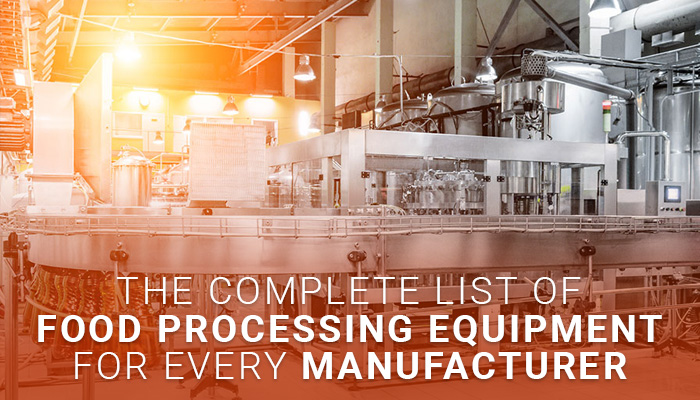
Food processing converts raw ingredients into food products that are attractive, marketable, and fit for consumption. Different food processing equipment are used to meet the varying requirements of manufacturing industries. As the industry grows and innovates, industrial food processing equipment also becomes diverse and more sophisticated to meet current demands and add greater value for investment.
If you are a food manufacturer who wants added benefits from your investment, you’d want to familiarize yourself with the extensive range of food processing equipment available in the market today.
The Different Types of Food Processing Equipment You Need to Know
Food Preparation
During food preparation, activities such as grading, sorting, peeling, or skinning are done to ensure the cleanliness of the raw materials. These involve wet and dry processes and for each, different food processing equipment is used.
Wet process preparation makes use of sterilizers, ultrasonic cleaners, floatation tanks, washing systems, and spray washers. On the other hand, the dry process preparation includes screening separators, air classifiers, and magnetic separators.
Food Processing Equipment for Grading
Grading is a process that ensures the overall quality of food products. It involves food assessment and makes use of different food processing equipment such as image processors, tungsten lights, and laboratory equipment.
Food Processing Equipment for Skinning
Also known as peeling, skinning is employed to improve the overall quality of the final food product. It gets rid of inedible or undesirable parts to separate the good. Essential food processing equipment such as abrasive rollers and bowls, pressure vessels, stationary and rotating blades, and conveyors and furnaces are employed to complete this process.
Food Processing Equipment for Sorting
In this operation, the food product is sorted to classify and separate contaminants and foreign matter from raw food materials. It is somewhat similar to dry cleaning. It makes use of sieves/screens for size sorting, sorting equipment, machine vision sorting systems, sorting conveyors, disc separators for shape sorting, as well as other food processing equipment used in the dry process.
Mechanical Processing
Aside from food preparation, mechanical processing is also done as the next step which often involves activities such as grinding/crushing, cutting, and forming.
Food Processing Equipment for Size Reduction
An initial step done in mechanical processing is size reduction. This intends to reduce the average particle size of solid food matter and involves shear, impact, or compression force.
Different mechanical processes are employed for the size reduction of food products,
- Grinding/Crushing: Roll crushers, Jaw crushers, Pressure and Impact Mills, Strainers/Pulpers, Attrition mills
- Cutting/Chopping: Slicing Machines, Knives/Blades, Meat Grinders, Band Saws
Food Processing Equipment for Size Enlargement
Unlike the previous operation, this process intends to increase the size of the food particle. It also involves a variety of mechanical processes such as:
- Extrusion: Twin-Screw extruders, Non-Thermal extruders, Refrigerated extruders, and Single-Screw extruders
- Agglomeration: Pelletizing equipment, Rotating drums and pans, tableting equipment, High-Speed agitators
- Forming: Confectionary molders, Bread molders, Enrobing machines, pie and biscuit formers
Food Processing Equipment for Homogenization/Emulsification
While this process involves the reduction of the average particle size of the food product it also increases the consistency of semi-solid and liquid food matter.
Some of the mechanical food processing equipment used for this process include high-shear mixers, emulsifiers, colloid mills, and homogenizers
Food Processing Equipment for Mixing/Blending
Mixing of food components is done to achieve and maintain a consistent mixture. This process combines and disperses two or more components into one another. The type of food processing equipment that will be used depends on the desired output.
- Solid: drum blended, diffusive mixers, convective mixers
- Fluid: anchor mixers, paddle mixers, turbine mixers, agitated tanks
- Dough/Paste: cutter mixers, sigma-blade mixers, horizontal dough mixers
The Importance of Food Processing Equipment
Food Safety
Food processing equipment and supplies contribute to ensuring high levels of hygiene and sanitation are maintained during food processing and handling. They prevent harmful microorganisms from contaminating food products
Examples: industrial dishwashers, sanitizing sprayers, and UV lamps
Food Quality
These machines also help in quality preservation. They maintain the freshness, flavor, texture, and nutritional value of food products.
Examples: Refrigeration systems, mixers, and slicers
Productivity
Efficiency improves productivity. With high-quality food processing equipment, it is easier to automate and streamline operations, labor costs are controlled, and production speed is enhanced. This impacts overall productivity and even revenue in the long run.
Examples: conveyor belts, industrial ovens, and filling machines
.
Compliance
Businesses in the food industry are bound by regulatory standards. These regulations are intended to protect consumers and ensure food safety, quality, and proper labeling.
Examples: metal detectors, label printers, and weighing scales
Product Development
Aside from ensuring productivity and regulatory compliance, food processing equipment is also used for product innovation. Food processors enable manufacturers to experiment with different ingredients, textures, and flavors to create something new.
Examples: homogenizers, food extruders, and flavor injectors
ALSO READ: 5 Conveyor Industry Trends in Manufacturing
The food processing industry is diverse, complex, and continuously evolving. Along with innovation, a wide variety of food processing equipment also emerged to meet changing demands. As crucial as they are in the development of the food industry, manufacturers should choose an industrial equipment company that meets their requirements.
Hayama Industrial Corporation provides exceptional services related to packaging equipment, toll packaging/manufacturing operations, environmentally related products, and promotion of agro-industrial and processing technologies. We can support your need for food production processes that guarantee a return on investment in the long run.
Send us a message today so we can discuss your requirements.

Recent Comments